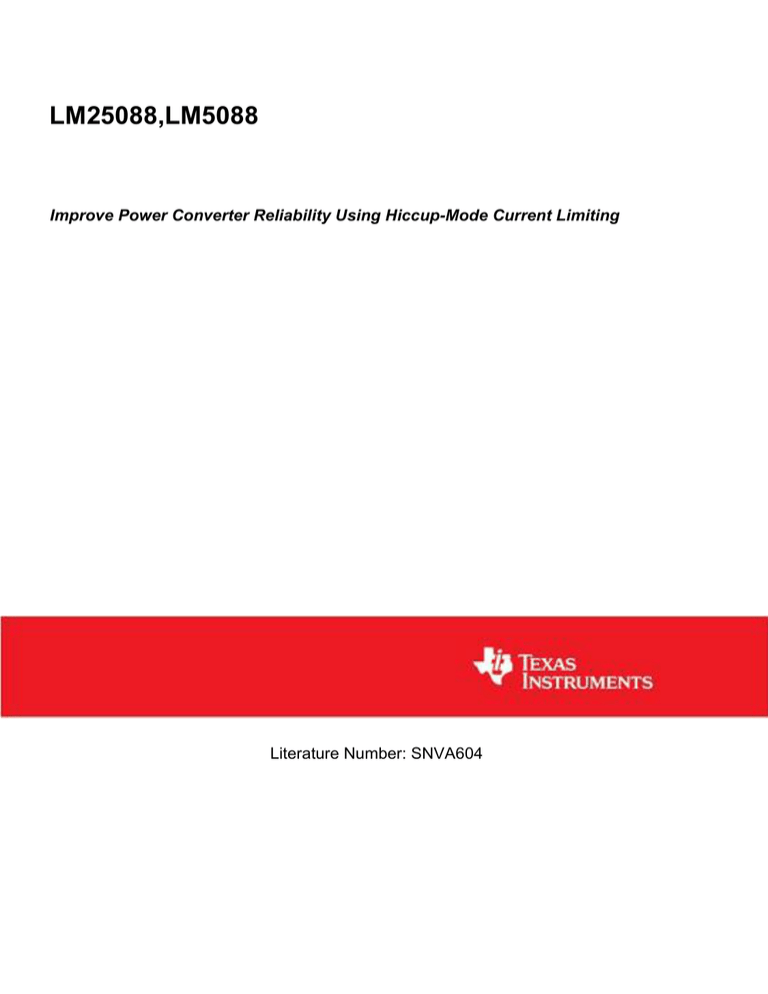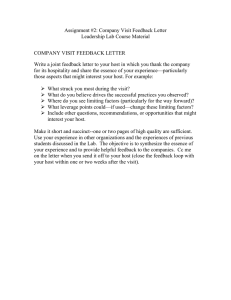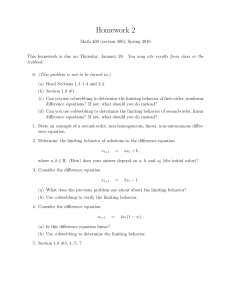Improve Power Converter Reliability Using
advertisement

LM25088,LM5088 Improve Power Converter Reliability Using Hiccup-Mode Current Limiting Literature Number: SNVA604 POWER designer Expert tips, tricks, and techniques for powerful designs No. 119 125 Feature Article ............... 1-6 Comms Applications ........2 Improve Power Converter Reliability Using Hiccup-Mode Current Limiting — By Ajay Hari, Senior Applications Engineer Introduction Switch-mode power supplies employ various schemes to protect themselves, and ideally the load, in overload conditions. Depending on whether the power converter automatically recovers and reverts back to normal operation once the overload condition is removed, overload protection schemes can be broadly classified into two categories: non-recoverable protection schemes (fuses, circuit breakers, overload shutdowns) and self-recoverable protection schemes (cycle-by-cycle current limiting and hiccup mode). The choice of protection scheme depends on the cost, complexity, and applicable safety standards. Non-recoverable schemes, such as the use of fuses, are popular in front-end off-line power conversion, and self-recoverable protection schemes are used typically in back-end DC-DC converters. Oftentimes, both of these types of schemes are implemented together to provide additional redundancy. Non-recoverable schemes are outside the purview of this article. Among self-recoverable protection schemes, cycle-by-cycle current limiting delivers maximum load current into the short circuit, thereby creating a thermal management problem. This complicates component and heat sink selection and if the components are not oversized, it can reduce the reliability of the system. Hiccup-mode protection solves the thermal management dilemma, and therefore improves system reliability and simplifies component selection. Overview of Self-Recoverable Overload Protection Schemes Cycle-by-cycle current limiting can be implemented by using peak, valley, or average inductor current information to detect the overload condition and limit the duty cycle. Peak current and valley cycle-by-cycle limiting are relatively simple schemes to implement. For example in a buck converter, a peak current limiting scheme is implemented by sensing the top switch current and, a valley current limiting scheme is implemented by sensing the bottom diode current (or bottom switch in a synchronous case). In peak current limiting, the PWM cycle is terminated (the top switch is turned-off) if the sensed current is greater than a predetermined threshold. In the case of High Efficiency. Low Power. Energy-Efficient Solutions for Communications Infrastructure National’s communications infrastructure solutions and subsystems are designed to meet the needs of wired data center, wireless base station, and merchant power systems. © 2009, National Semiconductor Corporation. National Semiconductor, , and PowerWise are registered trademarks. All rights reserved. Maximize infrastructure bandwidth and energy efficiency using National’s PowerWise® solutions. national.com/comms Wired and Data Center Applications PowerWise® Adaptive Voltage Scaling (AVS), a closed-loop voltage optimization technology, reduces both active and standby energy consumption in digital subsystems. Wireless Base Station Applications National’s high dynamic range receiver subsystems enable multi-carrier and multi-standard radios. Merchant and Point of Load Power Solutions National’s end-to-end power management solutions maximize power density and thermal dissipation. POWER designer Improve Power Converter Reliability Using Hiccup-Mode Current Limiting Valley Current Limit Threshold IOUT1 IOUT2 Peak Current Limit Threshold IOUT2 IOUT1 Time Figure 1. Inductor Current in Normal and Overload Conditions for Peak and Valley Cycle-by-Cycle Current Limiting Schemes valley current limiting, a PWM cycle is initiated if the sensed current is lower than the threshold. At the inception of current limit (soft-short), both of these schemes tend to have a soft-knee i.e. the output voltage drops slowly with increasing current. Figure 1 shows typical inductor current waveforms in peak and valley current limiting schemes and Figure 2 shows the VOUT versus IOUT versus curves for self-recoverable protection schemes, where softknee for peak and valley cycle-by-cycle current limiting is illustrated. Average current limiting converts the power converter from a constant voltage source into a constant current source. In this scheme the response is the same whether it is a soft-short or a hard-short, and thus, it is popularly known as “brick-wall limiting”. Average current limiting is typically implemented with a two-loop feedback system. A voltage amplifier is used to regulate the output voltage and a second current amplifier is used to regulate the average inductor current. Because of its two-loop system, average current limiting is slow to respond in hard-short current conditions. For this reason, it is implemented together with peak/valley cycle-bycycle current limiting for fast response. This scheme is therefore fairly complex and is often employed in bridge topologies to ensure transformer volt-second balance in overload conditions. The primary drawback of all three protection schemes is that during overload conditions, the average output current remains at a high level. The power converter, set by the reference to the current limit circuit, is delivering high load current into the load. This results in high power dissipation in the power train components, and all of the energy dumped into the load is not desirable. For example, in a buck converter employing a cycle-by-cycle current limiting mode and since the duty cycle is limited, the top switch is ON for a short period of time and the majority of the load is carried by the buck diode. This increases the power dissipation in the diode compared to normal running conditions. Unless the diode and heat sink are oversized to handle this condition, the reliability of the power converter is compromised in prolonged overload conditions. Foldback current limiting reduces power dissipation during overload conditions. In this scheme, as the output voltage falls during an overload condition, the current limit threshold is also reduced. Thus, it reduces the load current during fault conditions. This reduces power dissipation and eases thermal stresses on the power train components and the load. The main disadvantage of this scheme is that it is not completely self-recoverable. Once the fault is removed, the power converter can potentially enter a latch-up mode while powering constantcurrent loads. VOUT VOUT Peak/Valley Cycle-by-Cycle Limit Average Cycleby-Cycle Limit Load Current Foldback ICurrent_ Limit ILOAD ICurrent_ Limit/2 ICurrent_ Limit ILOAD Figure 2. VOUT vs. IOUT Curves for Various Cycle-by-Cycle Current-Limiting Schemes national.com/power 3 POWER designer Improve Power Converter Reliability Using Hiccup-Mode Current Limiting Hiccup-Mode Current Limiting A hiccup-mode current-limiting scheme can overcome all of the previously-mentioned disadvantages, i.e. it can solve the thermal dissipation problem during an overload condition and provide smooth self-recovery once the overload condition is removed. It is a simple scheme to implement and requires few external components when the logic is integrated into the PWM IC. Typically in a hiccup scheme once an overload condition is detected, the power converter is turned off and is forced into sleep mode. At the end of sleep time, a restart attempt is made by soft-starting the converter. If the overload condition persists, this process is repeated. Thus, the converter is in a loop of short bursts of pulses followed by a sleep time in a continuous overload condition, hence the name ‘hiccup’. The sleep time reduces the average load current and allows the power converter to cool down. after counting a number of cycle-by-cycle currentlimit events. Although simple to implement, the first approach is risky since hiccup can be invoked in transient load conditions and often requires additional logic to avoid false triggers. The second approach is virtually risk free and flexible in comparison. Figure 3 illustrates implementation of delayed hiccup-mode current limiting in a LM5088-2 buck controller. As shown in Figure 3, once an overload condition is detected, the present cycle is terminated and a current source is turned on to charge a capacitor. If the fault persists, the capacitor is charged every cycle; otherwise, the capacitor is discharged. If the voltage across the capacitor is above the predetermined threshold (start sleep-time REF), the SS capacitor is discharged. Thus, the power converter enters into a sleep mode. The hiccup capacitor is then discharged to another threshold (end sleeptime REF) which determines the sleep time. At the end of the sleep time, the soft-start capacitor is released and the soft-start begins. If the over- Two approaches are used typically to enter into sleep mode: by setting the hiccup threshold higher than the cycle-by-cycle current-limit threshold, hiccup is invoked only in hard-short conditions; and by using a counter which triggers hiccup only ICS Reset Present Cycle REF Current Limit Cycle CS + Charge Current REF RCS RES REF CRES ISS Non-Current Limit Cycle SS Discharge Current CSS Q S Q’ R + - + Start Sleep Time REF End Sleep Time REF Figure 3. Implementation of Hiccup-Mode Restart Timer in a LM5088-2 Buck Controller 4 POWER designer Improve Power Converter Reliability Using Hiccup-Mode Current Limiting Current Limit Persistent Delay Time Start Sleep Time Sleep Time Current Limit Detected End Sleep Time RES 0V SS Soft-Start PWM T1 T2 T3 Figure 4. Timing Diagram of a Delayed Hiccup-Mode Current-Limiting Scheme load persists, this cycle is repeated. The number of current-limit cycles required to establish the hiccup mode and sleep time are programmable by the choice of capacitor value. This flexibility allows the system designer to fine-tune the hiccup mode. Shorting the capacitor will result in continuous cycle-by-cycle current limiting. Figure 4 shows the timing diagram for the delayed hiccup-mode current-limiting scheme. In Figure 4, time period T1 is the delay time during which the persistence of an overload condition is checked by charging the hiccup capacitor to a predetermined value. Once it is established that the overload condition is persistent, the converter is forced into a sleep mode during the time period T2. With the delay time (T1) established, it prevents the converter from entering into sleep mode for load transient conditions. At the end of time period T2, a softstart cycle is initiated. Hiccup-mode current limiting, therefore, reduces the average load current during an overload condition. This in turn reduces the power dissipation in the power train and reduces the thermal stress on the components. Thermal Comparison between Cycle-by-Cycle and Hiccup-Mode Current Limiting For illustration purposes, let’s consider the LM5088-2, a non-synchronous buck controller with a hiccup-mode overload circuit. The hiccupmode scheme is as shown in Figures 3 and 4. The LM5088-2 controller requires just one external capacitor to configure the hiccup-mode feature, and if the hiccup pin is grounded, the part operates in a continuous cycle-by-cycle current-limiting mode only. Let’s further consider the LM5088-2 controller’s evaluation board with the following specifications: Frequency = 250 kHz Forward drop of buck diode = 0.5V Average load current during cycle-by-cycle limiting (IO) = 10A ON time of the top switch in current limit (TON) = 100 ns. D = 0.025 and (1-D) = 0.975 national.com/power 5 POWER designer Improve Power Converter Reliability Using Hiccup-Mode Current Limiting Continuous Cycle-by-Cycle Current Limiting Conduction loss of the buck diode in continuous current limiting is: Pdc _ diode = (1 − D ) × I o × V F = 4.8W The typical junction to ambient resistance of a D2Pak Schottky rectifier is about 18 °C/W (with heatsink). Therefore, the predicted junction temperature at an ambient temperature of 60 °C is: 60 ºC + 4.8W x 18 ºC/W =146.4 ºC Hiccup-Mode Current Limiting For calculation purposes, let’s assume 100 cycle-bycycle current limits before a sleep time of 500 µs is initiated, resulting in a diode duty cycle of 0.076. Conduction loss of the buck diode in continuous current limiting is: Pdc _ diode = (1 − D ) × I o × V F = 0.38W Therefore, the predicted junction temperature at an ambient temperature of 29 °C is: 25 ºC + 0.38W x 18 ºC/W =32 ºC It should be noted also that the temperature of the PC board is also lowered due to the sleep time. Figure 5a shows the thermal image of the LM5088 board in peak cycle-by-cycle current limiting and Figure 5b shows the thermal image of the LM5088 board in hiccup-mode current limiting. It can be inferred from the calculations and thermal images that the cycle-by-cycle case is unsustainable since the junction temperature can exceed the rated temperature for the diode. And in prolonged overload conditions, this can reduce the reliability of the power converter. The hiccup-mode scheme, however, keeps the power converter cool and also does not require the components to be derated for elevated temperature. Therefore, hiccup-mode current limiting not only simplifies component selection but also enhances the reliability of the power converter. 160 ºC 160 ºC 20 ºC 20 ºC Figure 5a. Cycle-by-Cycle Current Limiting Figure 5b. Hiccup-Mode Current Limiting Figure 5. Thermal Image of the LM5088 Evaluation Board 6 Power Design Tools Tools for Energy-Efficient Designs Access white papers, reference designs, and application notes on PowerWise® products and systems. national.com/powerwise Technology Edge App Notes National’s monthly analog design technical journal. national.com/edge Online Seminars Free online seminars by industry experts. Log onto National's analog online seminars today. national.com/onlineseminars National Semiconductor 2900 Semiconductor Drive Santa Clara, CA 95051 1 800 272 9959 Mailing address: PO Box 58090 Santa Clara, CA 95052 Visit our website at: national.com For more information, send email to: new.feedback@nsc.com Don’t miss a single issue! Subscribe now to receive email alerts when new issues of Power Designer are available: nnational.com/powerdesigner Read our Signal Path Designer® oonline today at: nnational.com/spdesigner ©2009, National Semiconductor Corporation. National Semiconductor, , PowerWise, and Signal Path Designer are registered trademarks of National Semiconductor. All other brand or product names are trademarks or registered trademarks of their respective holders. All rights reserved. 550263-019 IMPORTANT NOTICE Texas Instruments Incorporated and its subsidiaries (TI) reserve the right to make corrections, modifications, enhancements, improvements, and other changes to its products and services at any time and to discontinue any product or service without notice. Customers should obtain the latest relevant information before placing orders and should verify that such information is current and complete. All products are sold subject to TI’s terms and conditions of sale supplied at the time of order acknowledgment. TI warrants performance of its hardware products to the specifications applicable at the time of sale in accordance with TI’s standard warranty. Testing and other quality control techniques are used to the extent TI deems necessary to support this warranty. Except where mandated by government requirements, testing of all parameters of each product is not necessarily performed. TI assumes no liability for applications assistance or customer product design. Customers are responsible for their products and applications using TI components. To minimize the risks associated with customer products and applications, customers should provide adequate design and operating safeguards. TI does not warrant or represent that any license, either express or implied, is granted under any TI patent right, copyright, mask work right, or other TI intellectual property right relating to any combination, machine, or process in which TI products or services are used. Information published by TI regarding third-party products or services does not constitute a license from TI to use such products or services or a warranty or endorsement thereof. Use of such information may require a license from a third party under the patents or other intellectual property of the third party, or a license from TI under the patents or other intellectual property of TI. Reproduction of TI information in TI data books or data sheets is permissible only if reproduction is without alteration and is accompanied by all associated warranties, conditions, limitations, and notices. Reproduction of this information with alteration is an unfair and deceptive business practice. TI is not responsible or liable for such altered documentation. Information of third parties may be subject to additional restrictions. Resale of TI products or services with statements different from or beyond the parameters stated by TI for that product or service voids all express and any implied warranties for the associated TI product or service and is an unfair and deceptive business practice. TI is not responsible or liable for any such statements. TI products are not authorized for use in safety-critical applications (such as life support) where a failure of the TI product would reasonably be expected to cause severe personal injury or death, unless officers of the parties have executed an agreement specifically governing such use. Buyers represent that they have all necessary expertise in the safety and regulatory ramifications of their applications, and acknowledge and agree that they are solely responsible for all legal, regulatory and safety-related requirements concerning their products and any use of TI products in such safety-critical applications, notwithstanding any applications-related information or support that may be provided by TI. Further, Buyers must fully indemnify TI and its representatives against any damages arising out of the use of TI products in such safety-critical applications. TI products are neither designed nor intended for use in military/aerospace applications or environments unless the TI products are specifically designated by TI as military-grade or "enhanced plastic." Only products designated by TI as military-grade meet military specifications. Buyers acknowledge and agree that any such use of TI products which TI has not designated as military-grade is solely at the Buyer's risk, and that they are solely responsible for compliance with all legal and regulatory requirements in connection with such use. TI products are neither designed nor intended for use in automotive applications or environments unless the specific TI products are designated by TI as compliant with ISO/TS 16949 requirements. Buyers acknowledge and agree that, if they use any non-designated products in automotive applications, TI will not be responsible for any failure to meet such requirements. Following are URLs where you can obtain information on other Texas Instruments products and application solutions: Products Applications Audio www.ti.com/audio Communications and Telecom www.ti.com/communications Amplifiers amplifier.ti.com Computers and Peripherals www.ti.com/computers Data Converters dataconverter.ti.com Consumer Electronics www.ti.com/consumer-apps DLP® Products www.dlp.com Energy and Lighting www.ti.com/energy DSP dsp.ti.com Industrial www.ti.com/industrial Clocks and Timers www.ti.com/clocks Medical www.ti.com/medical Interface interface.ti.com Security www.ti.com/security Logic logic.ti.com Space, Avionics and Defense www.ti.com/space-avionics-defense Power Mgmt power.ti.com Transportation and Automotive www.ti.com/automotive Microcontrollers microcontroller.ti.com Video and Imaging RFID www.ti-rfid.com OMAP Mobile Processors www.ti.com/omap Wireless Connectivity www.ti.com/wirelessconnectivity TI E2E Community Home Page www.ti.com/video e2e.ti.com Mailing Address: Texas Instruments, Post Office Box 655303, Dallas, Texas 75265 Copyright © 2011, Texas Instruments Incorporated




